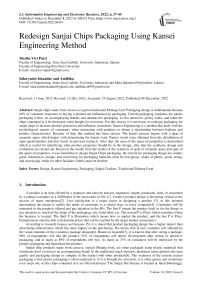Redesign Sanjai Chips Packaging Using Kansei Engineering Method
Автор: Meylia Vivi Putri, Isdaryanto Iskandar, Andhika
Журнал: International Journal of Information Engineering and Electronic Business @ijieeb
Статья в выпуске: 6 vol.14, 2022 года.
Бесплатный доступ
Sanjai chips made from cassava is typical tradisional Minang food. Packaging design is fundamental because 89% of consumer responses to buying a product are influenced by packaging. Current packaging weakness are plastic packaging is thin, no accompanying brands, and unattractive packaging, so less attractive, greasy, leaks, and make the chips contained in it be destroyed when bought for souvenirs. For this reason, it is necessary to redesign packaging for sanjai chips to increase product protection and influence consumers. Kansei Engineering is a method that deals with the psychological aspects of consumers when interacting with products to obtain a relationship between feelings and product characteristics. Because of that, this method has been chosen. The kansei process begins with a span of semantic space which begins with determining the kansei word. Kansei words were obtained from the distribution of open questionnaires and also based on previous research. After that, the span of the space of properties is determined which is useful for identifying what product properties should be in the design. after that the synthesis, design and evaluation are carried out. Based on the results from the results of the synthesis of span of semantic space and span of the space of properties, it was found that to design Sanjai Chips packaging, the criteria for packaging design are simple, good, informative, unique, and convincing for packaging materials must be non-greasy, made of plastic, good, strong, and convincing, while for other facilities criteria must be flexible.
Design, Kansei Engineering, Packaging, Sanjai Crackers, Tradisional Minang Food
Короткий адрес: https://sciup.org/15018795
IDR: 15018795 | DOI: 10.5815/ijieeb.2022.06.04
Текст научной статьи Redesign Sanjai Chips Packaging Using Kansei Engineering Method
Published Online on December 8, 2022 by MECS Press
A product is an item offered by a producer and must be noticed, requested, sought, purchased, used, or consumed by a market consumer as a fulfillment of the necessities of life [1]. Creative product design is becoming critical to the success of many enterprises[2]. User satisfaction is a major factor in designing a product [3], in this moment determining the means to satisfy the needs of customers is a crucial issue in every company[4]. Consumers will be interested in the products offered and pay attention to the 4Ps. The first P means the product itself as for the things to pay attention to, much of the shape of the packaging, size, halal label, etc. The second P is Place which considers where the business is located. The third P is Promotion which means how to market the product, and the last P is Price. Entrepreneurs must be able to determine prices that can be reached by the target market (consumers).
According to research Gemmy and Haryanto [5], it is stated that product packaging design has a higher impact than advertising attractiveness which has more impact on the purchasing. We knows that in fact, customer will affected by the visual elements of the cosmetics package designs[6]. Based on research[7], it is known that after seeing a package, 90% of respondents will like the product. 92% of respondents will attract development after seeing its attractive packaging, and as many as 89% of respondents will buy. As many as 73% of consumers will be impressed by the product packaging and repurchase the product.
Sanjai chip products made from cassava, typical Minang food, are often packaged using plastic materials that sometimes don't even have an accompanying brand. In the traditional snack business, producers must optimize the taste quality and packaging design to compete in the market with other products[8]. The weakness of the current cracker packaging is that plastic packaging is often unattractive. If it is brought for souvenirs, it is often greasy and sometimes even seeps out, so the chips contained in it are often destroyed. The Sanjai Nel furnace is located at Jalan Bukittinggi,
Medan Km 4, Gadut, Kec. Tilatang Kamang, Kab. Agam sells various types of sanjai, which are self-produced.
Currently, the packaging design in the SME (Small Medium Enterprise) Tungku Sanjai Nel is still wrapped using plastic with the packaging logo given. Still, unfortunately, the packaging logo is not visible and sometimes even fades due to seeping oil or friction. Therefore, this study aims to design/design a package of Sanjai chips using the Kansei Engineering Method. This study only discusses how to redesign the packaging of Sanjai chips using the Kansei Engineering method without considering the cost factor. Kansei engineering is a practical tool for perceptual demand analysis[9]. Kansei is a Japanese word that means consumers' feelings and psychological imagery about new products. Kansei Engineering aims to produce new products based on the feelings and demands of consumers[10,3]so this method can describe the wishes of consumers[11,12] and provides relevant [13]economic benefit. Kansei is an ambiguous term coined in Japan[14]. Kansei Engineering (KE) method evaluates the user's emotional needs and their conversion to tangible product features or task[15] then translates them into product parameters [16]. Sometimes, visual attributes such as color, form, texture [17] and style can be more important than ergonomic or technical attributes in consumer purchase decisions[18] and cognitive designs were more emphasized than the physical ones[19].
Nowadays, product design pays more attention to the improvement of the user experience[20] and emotional satisfaction (Kansei)[21] or emotional perception[22]. The customer satisfaction variable has a significant effect on customer loyalty[11]. Based on previous study we can summarize that the design scheme optimized by this method better fits the user’s perceptual imagery index, and thus the user’s task operation experience was better [23].
2. Research Method
The Kansei Engineering method focuses on consumer desires that are implicit or not so clear and vague. Packaging design is done based on consumer desires. Consumer desires are unspoken. Therefore the suitable packaging design is done using the Kansei Engineering (KE) method. The framework of this study can be seen in Fig.1.
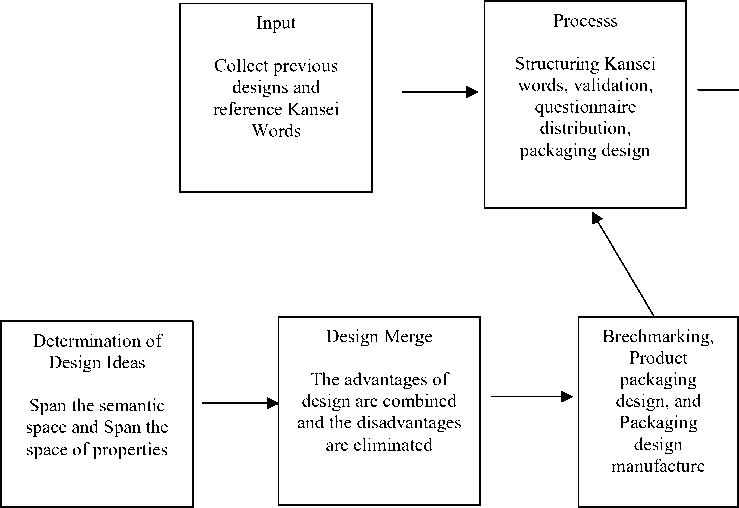
Fig. 1. Final Design of Sanjai Nel Cracker Packaging
Output
Sanjai cracker packaging design
The methods used in data collection are observation, interviews, distributing questionnaires, and study literature. It starts an observation of a customer’s behavior, grasps his or her emotion using psychological scaling, and analyzes their emotion using several statistical analyses to lead design items. Finally, we create a new model of product with which customers will satisfy[24]. The recommendations given are carried out by understanding the emotional desire (Kansei) based on the consumer's image of the sanjai chip packaging using the Kansei Engineering Method. The kansei engineering method can help to realize the research objective, namely to produce a sanjai cracker package that is able to protect and influence consumers by looking for design criteria that consumers expect based on consumer feelings. The following steps are choice of domain, span the semantic space, synthesis, redesign, and evaluation.
-
2.1 Choice of Domain
-
2.2 Span the semantic space
The first process in Kansei Engineering is to determine the domain. Choice of the domain is the selection of the target group of a product. Usually, the product is specified by the function, type, and others. The product domain chosen in this study is the packaging of sanjai chips which are often used as souvenirs when people come to Bukittinggi, West Sumatra.
Span the semantic space is the stage of collecting Kansei words, grouping the Kansei words (the structure of Kansei words), and the last step is recapitulating the Kansei word. Initial data collection was carried out by
Kansei word identification is made using direct open interviews and questionnaires. Then the Kansei words were structured. After that, a questionnaire was designed to determine how important the Kansei words were when they wanted to buy sanjai chips. Kansei word weighting that has been structured is done using a semantic differential scale questionnaire[25]. The choice points provided are 7 points. The sample used to be the respondent was calculated using the lameshow formula. The sample will greatly affect the representation of the population in the research process. In survey research, usually, the formula is used in binomial proportions. If the population size (N) is known, then the sample cross-sectional formula will be used; if N is not, the Lemeshow formula will be used. Due to this case, the number of customers cannot be known. Therefore the lameshow formula is used. Lameshow formula can be seen in (1).
(2^1
d2
Explanation:
N: Minimum number of samples
(Z ^ ): The probability value on the normal curve based on the level of confidence
-
p: Proportion of the number of samples considered correct
-
q: Proportion of the number of samples considered wrong
-
d: Levelaccuracy
-
2.3 Spanthe space of properties
-
2.4 Synthesis
-
2.5 Sanjai Chips Packaging Design
-
2.6 Design Analysis and Evaluation
By using (1) using the value of Z is 1.96, the p-value is 0.5 and q-value is 0.5, and the level of accuracy is
10%, then the minimum number of samples that must be taken is 97. After that, validity and reliability tests are carried out. Validity testing is done by calculating the correlation of each question using SPSS 22 software. The significant level value used is 5%, and the degree of freedom is df = N-2. The purpose of this reliability test is to analyze whether the questionnaire used as a measuring tool is reliable or reliable if a person's answers to questions are consistent from time to time. This reliability test uses SPSS 22 software. The variable is said to be reliable if the Croncbach Alpha value is greater than 0.6.
This stage aims to find out which packaged product items under study are related to the Kansei words of their consumers, such as packaging durability, packaging design, etc. Product properties are determined based on journals and literature on how good and correct packaging fits its function and also based on researchers' knowledge about the packaging.
The synthesis stage is the stage that connects the Span the Semantic Space and the Span the Space of Properties simultaneously. Kansei factors have been selected based on the analysis of factors that represent the emotional and consumer desires associated with product properties.
From the results of the synthesis that have been determined, then the attributes that must be included in the design are determined.
At this stage, the analysis and interpretation of the research results in the form of the Sanjai packaging design are described as well as an analysis of the designs that have been produced.
The steps to be carried out in this research can be seen in Fig 2. Fig 2 shows that the research begins with the study literature. Literature study is done by looking at previous related studies, looking at other product packaging designs, and studying the nature or characteristics of consumers, after that identification of the problem which is the main problem in this research is the product packaging design, after that the formulation and goal determination problems are carried out. After that, the domain selection in this research is sanjai crackers. Then the process of collecting kansei words and processing kansei data is carried out, after that it is designed, evaluated and analyzed.
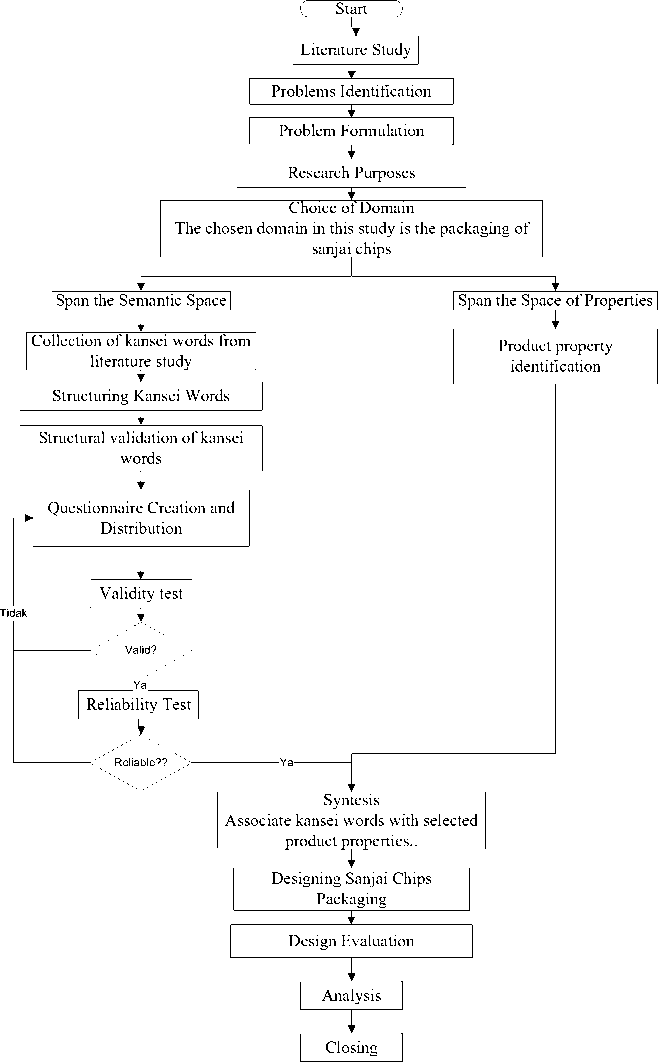
Fig. 2. Research Flowchart
3. Results and Discussion
Based on the results of the initial questionnaire distribution to 10 initial respondents to get Kansei words regarding the packaging of Sanjai chips, plus based on the results of previous research literature studies collected 87 Kansei words that still have the same meaning/meaning/words. Then elimination is done by eliminating/reducing words that have the same meaning. Based on the results of the elimination, 16 words were removed, resulting in 71 words. From the results of the 71 words, the Kansei words were structured. Kansei structuring is done by grouping words based on similar characteristics manually and subjectively, which is the result of thinking and intuition [26]. Kansei words that have the same meaning or close meaning will be grouped into a single group and processed using an affinity diagram. Then the grouped words will be represented by the strongest and most precise word meaning so that the word can represent the word indicator. From the results of Kansei structuring, 9 Kansei Words are produced, namely non-greasy, simple, plastic, good, flexible, strong, informative, unique, and convincing. Then the questionnaire was distributed. Based on the results of the questionnaire distribution, the results of the validity test can be seen in Table 1. From the results of
Kansei structuring, 9 Kansei Words are produced: non-greasy, simple, plastic, good, flexible, strong, informative, unique, and convincing. Then the questionnaire was distributed. Based on the results of the questionnaire distribution, the results of the validity test can be seen in Table 1. From the results of Kansei structuring, 9 Kansei Words are produced, namely non-greasy, simple, plastic, good, flexible, strong, informative, unique, and convincing. Then the questionnaire was distributed. Based on the results of the questionnaire distribution, the results of the validity test can be seen in Table 1.
Table 1. Table of Validity Test Results with SPSS
Item- Tital Statistics
|
Scale Mean if Item Deleted |
Scale Variance if Item Deleted |
Corrected Item-Total Correlation |
Squared Multiple Correlation |
Cronbach's Alpha if Item Deleted |
|
|
Non-greasy |
51.7071 |
7.903 |
.596 |
.662 |
.579 |
|
Simple |
51.6566 |
8.493 |
.454 |
.516 |
.621 |
|
Plastic |
51.4242 |
9.92 |
.221 |
.175 |
.679 |
|
Good |
51.0303 |
10.519 |
.287 |
.211 |
.660 |
|
Flexible |
51.3636 |
9.581 |
.379 |
.737 |
.641 |
|
Strong |
51.3131 |
9.503 |
.446 |
.754 |
.628 |
|
Informative |
50.9899 |
10.928 |
.242 |
.708 |
.667 |
|
Unique |
51.5253 |
9.578 |
.292 |
.402 |
.662 |
|
Convincing |
50.9697 |
10.928 |
.254 |
.717 |
.666 |
The number of respondents is 99 people. Therefore the value of r table used is 0.1975. The tested data is valid if the value of r count > r table. Validity is taken from the corrected items-Total Correlation value. Based on this value, it is already greater than r table for that all questions are valid. The results of the reliability test can be seen in Table 2.
Table 2. Table of Reliability Test Results
|
Reliability Statistics |
||
|
Cronbach's |
Cronbach's |
N of |
|
Alpha |
Alpha Based on Standardized Items |
Items |
|
.674 |
.679 |
9 |
The variable is said to be reliable if Croncbach's Alpha value is greater than 0.6. The Croncbach Alpha value obtained is 0.674. Because 0.674 > 0.6, then the questionnaire used is declared reliable. For the determination of the Span of Semantic Properties, it is obtained from the identification of the sub-dimensions possessed by the previous packaging, which is used as a reference. Based on the research of Rahmayani et al. [27], the required sub-dimensions are Packaging Design, Functional Packaging, Durability, and other facilities. Mu'alim and Hidayat proposed colors, designs, packaging standards, logos, and motifs[8]. Materials, motifs, and supporting facilities were proposed by Faisal et al. [28], adorable, and simply expressed by Nugroho et al. [29]. Graphic Design, design structure, and product information are presented by Sari [30], as well as packaging materials, packaging forms, designs, and accessories. In the synthesis stage, relationship between factors of span of semantic properties and span of semantic space is studied. The results of the synthesis can be seen in Table 3. In the synthesis stage, the relationship between the factors of the span of semantic properties and the span of semantic space is studied. The results of the synthesis can be seen in Table 3.
Table 3. Synthesis Results
|
No |
Factor |
Kansei Word |
|
1 |
Packaging Design |
Simple Good Informative Unique Convincing |
|
2 |
Packaging Material |
Not greasy |
|
Plastic Good |
||
|
Strong Convincing |
||
|
3 |
Other Facilities |
Flexible |
From the results of the synthesis that have been determined, then the attributes in the design are determined. Attributes/design criteria that must exist can be seen in Table 4.
Table 4. Attributes/ Criteria design
|
No |
Factor |
Kansei Word |
Attributes/ Design criteria |
|
1 |
Packaging Design |
Simple Good Informative Unique Convincing |
The design does not have too many pictures, and the colors and writing are clear. Nice to look at and gives its charm Have a logo and detailed product information such as product images, variants, production date, expiration date, production code, production address, composition, and a brief explanation regarding food, weight, etc. Given characteristics such as the Rumah Gadang logo, red, yellow, or black colors which are unique to West Sumatra, there is a brief explanation regarding food and the words benchmarking products. The contents of the crackers can be seen (there is a transparent part) |
|
2 |
Packaging Material |
Not greasy Plastic Good Strong Convincing |
Closing and opening tightly, equipped with a zipper. Made of plastic Good material Strong material The ingredients are believed to protect the contents of the product |
|
3 |
Other Facilities |
Flexible |
It can be opened and closed and can be taken anywhere equipped with a hand grip. |
Based on the design criteria that have been obtained, the authors designed a packaging design from Sanjai crackers. Can be seen in Fig. 3
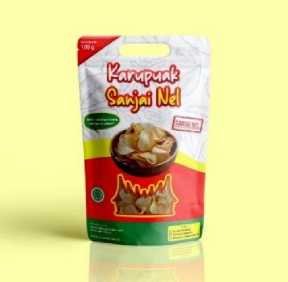
Fig. 3. Final Design of Sanjai Nel Cracker Packaging
Evaluation is done by seeing whether the design formed is in accordance with the criteria or attributes that have been determined. The results of the evaluation of the design can be seen in Table 5.
Table 5. Results of Design Evaluation
|
No |
Factor |
Kansei Word |
Attributes/ Design criteria |
Fulfilled / No? |
|
1 |
Packaging |
Simple |
The design does not have too many pictures, and the colors and writing are clear. |
fulfilled |
|
Design |
Good |
Nice to look at and gives its charm |
fulfilled |
|
|
Informative |
Have a logo and detailed product information such as product images, variants, production date, expiration date, production code, production address, composition, and a brief explanation regarding food, weight, etc. |
fulfilled |
||
|
Unique |
Given characteristics such as the Rumah Gadang logo, red, yellow, or black colors which are unique to West Sumatra, there is a brief explanation regarding food and the words benchmarking products. |
fulfilled |
||
|
Convincing |
The contents of the crackers can be seen (there is a transparent part) |
fulfilled |
||
|
2 |
Packaging |
Not greasy |
Closing and opening tightly, equipped with a zipper |
fulfilled |
|
Material |
Plastic |
Made of plastic |
fulfilled |
|
|
Good |
Good material |
fulfilled |
||
|
Strong |
Strong material |
fulfilled |
||
|
Convincing |
The ingredients are believed to protect the contents of the product |
fulfilled |
||
|
3 |
Other Facilities |
Flexible |
It can be opened and closed and can be taken anywhere equipped with a hand grip |
fulfilled |
Based on the results of design validation that we can seen in table 5, it can be seen that the newly created design can meet all the criteria that have been found using the Kansei engineering method. The comparison between the old and new designs can be seen in Table 6.
Table 6. Comparison between old and new design
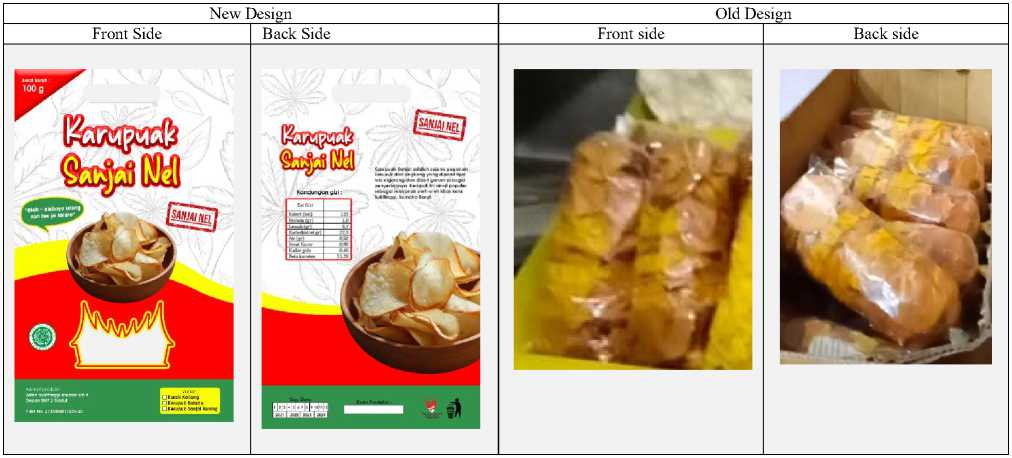
Based on Table 6., The comparison of the design before and after the research, it can be concluded that before the redesign the existing design was not good and too simple because it was only made of clear plastic, there was no logo, and product details such as nutritional content, history, or certification (less informative) . the current design is also not unique because there are no characteristics that show a cultural characteristic. However, after the design, it can be seen that the existing design is simple, good, informative and unique, because the design has an attractive appearance, has a logo, product details, and is characterized as the formation of a gadang house and an explanation of culture. Based on the material used, the old design and the new design can both display the contents of the product, both are made of plastic, and are made of strong and sturdy materials. However, for other facilities, the old packaging is not flexible because the product cover only uses a rubber band, while the new design uses a zipper and has a handgrip on it.
4. Conclusions
Creative product design is critical key success of many companies. User goals are the main factors in designing a product, nowadays determining the means to meet customer needs is a crucial issue in every company. Product packaging design has better impact than advertising.. This research was conducted to design the packaging of sanjai chips using the Kansei Engineering method to improve user experience and satisfaction, then it will have an impact on consumer loyalty. The methods used in data collection are observation, interviews, questionnaires, and literature study. starting with observing customer behavior, capturing their emotions using a psychological scale, and analyzing their emotions using some statistical analysis to lead the item design. Finally, we create new product models that will satisfy customers.
The recommendations given are carried out by understanding the emotional desire (Kansei) based on the consumer's image of the packaging of sanjai chips using the Kansei Engineering Method. The steps taken in processing the data begin with domain selection, span the semantic space, span the space of properties, synthesis, redesign, and evaluation. Based on the results of the study from synthesis of span of semantic space and span of the space of properties, it can be concluded that to design the packaging for Sanjai chips, the criteria for packaging design are simple, good, informative, unique, and convincing. The criteria for packaging materials must be non-greasy, made of plastic, good, strong, and convincing, while other facilities that are expected to have a design are that the packaging must be flexible.
It is better for future research to also consider the cost factor in designing product packaging and not only using the Kansei engineering method but also like quality function deployment method or other method.
Список литературы Redesign Sanjai Chips Packaging Using Kansei Engineering Method
- D. T. Permadi, N. W. P. Susatyo, and D. Pujotomo, “ENGINEERING.”
- H. Quan, S. Li, and J. Hu, “Product innovation design based on deep learning and Kansei engineering,” Appl. Sci., vol. 8, no. 12, pp. 1–17, 2018, doi: 10.3390/app8122397.
- I. G. T. Isa, “Kansei Engineering Approach in Software Interface Design,” J. Sci. Innovare, vol. 1, no. 01, pp. 22–26, 2018, doi: 10.33751/jsi.v1i01.680.
- M. D. Shieh, Y. Li, and C. C. Yang, “Comparison of multi-objective evolutionary algorithms in hybrid Kansei engineering system for product form design,” Adv. Eng. Informatics, vol. 36, no. February, pp. 31–42, 2018, doi: 10.1016/j.aei.2018.02.002.
- H. Gemmy and J. O. Haryanto, “Factors Influence Brand Awareness Towards Purchasing Intention on Susu Kental Manis Frisian Flag,” Int. J. Bus. Stud., vol. 3, no. 2, pp. 40–53, 2019.
- N. B. A. Mohamed, I. G. Medina, and Z. G. Romo, “The effect of cosmetics packaging design on consumers’ purchase decisions,” Indian J. Mark., vol. 48, no. 12, pp. 50–61, 2018, doi: 10.17010/ijom/2018/v48/i12/139556.
- H. Vyas, “Packaging Design Elements and Users Perception: a context in fashion branding and communication,” J. Appl. Packag. Res., vol. 7, no. 2, p. 5, 2015.
- Mu’alim and R. Hidayat, “Re-Desain Kemasan dengan Metode Kansei Engineering,” J. Al-AZHAR Indones. SERI SAINS DAN Teknol., vol. 2, no. 4, p. 215, 2015, doi: 10.36722/sst.v2i4.156.
- X. Lai, S. Zhang, N. Mao, J. Liu, and Q. Chen, “Kansei engineering for new energy vehicle exterior design: An internet big data mining approach,” Comput. Ind. Eng., vol. 165, p. 107913, 2022, doi: https://doi.org/10.1016/j.cie.2021.107913.
- R. Ginting, A. Ishak, A. Fauzi Malik, and M. R. Satrio, “Integration of kansei engineering and quality function deployment (qfd) for product development : A literature review,” IOP Conf. Ser. Mater. Sci. Eng., vol. 1003, no. 1, 2020, doi: 10.1088/1757-899X/1003/1/012020.
- D. P. Restuputri, T. R. Indriani, and I. Masudin, “The effect of logistic service quality on customer satisfaction and loyalty using kansei engineering during the COVID-19 pandemic,” Cogent Bus. Manag., vol. 8, no. 1, 2021, doi: 10.1080/23311975.2021.1906492.
- M. Nagamachi, “Kansei engineering: a new ergonomic consumer-oriented technology for product development,” Int. J. Ind. Ergon., vol. 15, no. 1, pp. 3–11, 1995.
- E. Coronado, G. Venture, and N. Yamanobe, “Applying Kansei/Affective Engineering Methodologies in the Design of Social and Service Robots: A Systematic Review,” Int. J. Soc. Robot., vol. 13, no. 5, pp. 1161–1171, 2021, doi: 10.1007/s12369-020-00709-x.
- A. Hashizume and M. Kurosu, “‘Kansei Engineering’ as an Indigenous Research Field Originated in Japan,” in International Conference on Human-Computer Interaction, 2016, pp. 46–52.
- S. Kalantary and J. N. Seraji, “The Concept of Hedonomics and Kansei Engineering Method in Ergonomics: A Narrative Overview,” Int. J. Occup. Hyg., vol. 9, no. 3, pp. 1–8, 2017.
- W. M. Wang, J. W. Wang, Z. Li, Z. G. Tian, and E. Tsui, “Multiple affective attribute classification of online customer product reviews: A heuristic deep learning method for supporting Kansei engineering,” Eng. Appl. Artif. Intell., vol. 85, no. May, pp. 33–45, 2019, doi: 10.1016/j.engappai.2019.05.015.
- Y.-M. Chang and C.-W. Chen, “Kansei assessment of the constituent elements and the overall interrelations in car steering wheel design,” Int. J. Ind. Ergon., vol. 56, pp. 97–105, 2016.
- A. Green and V. Chattaraman, Creating an affective design typology for basketball shoes using kansei engineering methods, vol. 774. Springer International Publishing, 2019.
- M. Ziaei, S. Y. Hosseini, H. Shariati, and E. Khoshboo, “Association between occupational burnout and quality of life among healthcare workers,” 2015.
- L. Xue, X. Yi, and Y. Zhang, “Research on optimized product image design integrated decision system based on Kansei engineering,” Appl. Sci., vol. 10, no. 4, 2020, doi: 10.3390/app10041198.
- M. Hartono, “The modified Kansei Engineering-based application for sustainable service design,” Int. J. Ind. Ergon., vol. 79, no. January 2019, p. 102985, 2020, doi: 10.1016/j.ergon.2020.102985.
- Y. H. Hsiao, M. C. Chen, and W. C. Liao, “Logistics service design for cross-border E-commerce using Kansei engineering with text-mining-based online content analysis,” Telemat. Informatics, vol. 34, no. 4, pp. 284–302, 2017, doi: 10.1016/j.tele.2016.08.002.
- Q. Fu, J. Lv, S. Tang, and Q. Xie, “Optimal design of virtual reality visualization interface based on kansei engineering image space research,” Symmetry (Basel)., vol. 12, no. 10, pp. 1–22, 2020, doi: 10.3390/sym12101722.
- M. Nagamachi, “History of Kansei engineering and application of artificial intelligence,” Adv. Intell. Syst. Comput., vol. 585, pp. 357–368, 2018, doi: 10.1007/978-3-319-60495-4_38.
- C. E. Osgood, W. H. May, M. S. Miron, and M. S. Miron, Cross-cultural universals of affective meaning, vol. 1. University of Illinois Press, 1975.
- S. Schütte, “Engineering emotional values in product design: Kansei engineering in development.” Institutionen för konstruktions-och produktionsteknik, 2005.
- N. Rahmayani, Yuniar, and A. Desrianty, “Rancangan Kemasan Bedak Tabur (Loose Powder) Dengan Menggunakan Metode Kansei Engineering,” J. Online Inst. Teknol. Nas., vol. 03, no. 04, pp. 170–179, 2015.
- D. Faisal, L. D. Fathimahhayati, and F. D. Sitania, “Penerapan Metode Kansei Engineering Sebagai Upaya Perancangan ulang Kemasan Takoyaki ( Studi Kasus : Takoyakiku Samarinda ),” J. TEKNO (Civil Engineeering, Elektr. Engineeering Ind. Engineeering), vol. 18, no. April, pp. 92–109, 2021.
- S. Nugroho, D. Pujotom, and M. M. Ulkhaq, “Redesain Kemasan Makanan Ringan Olahan,” Performa, vol. 16, no. 1, pp. 77–86, 2017.
- M. Sari, “Desain ulang kemasan rendang menggunakan metode kansei engineering,” Universitas Andalas, 2018.

